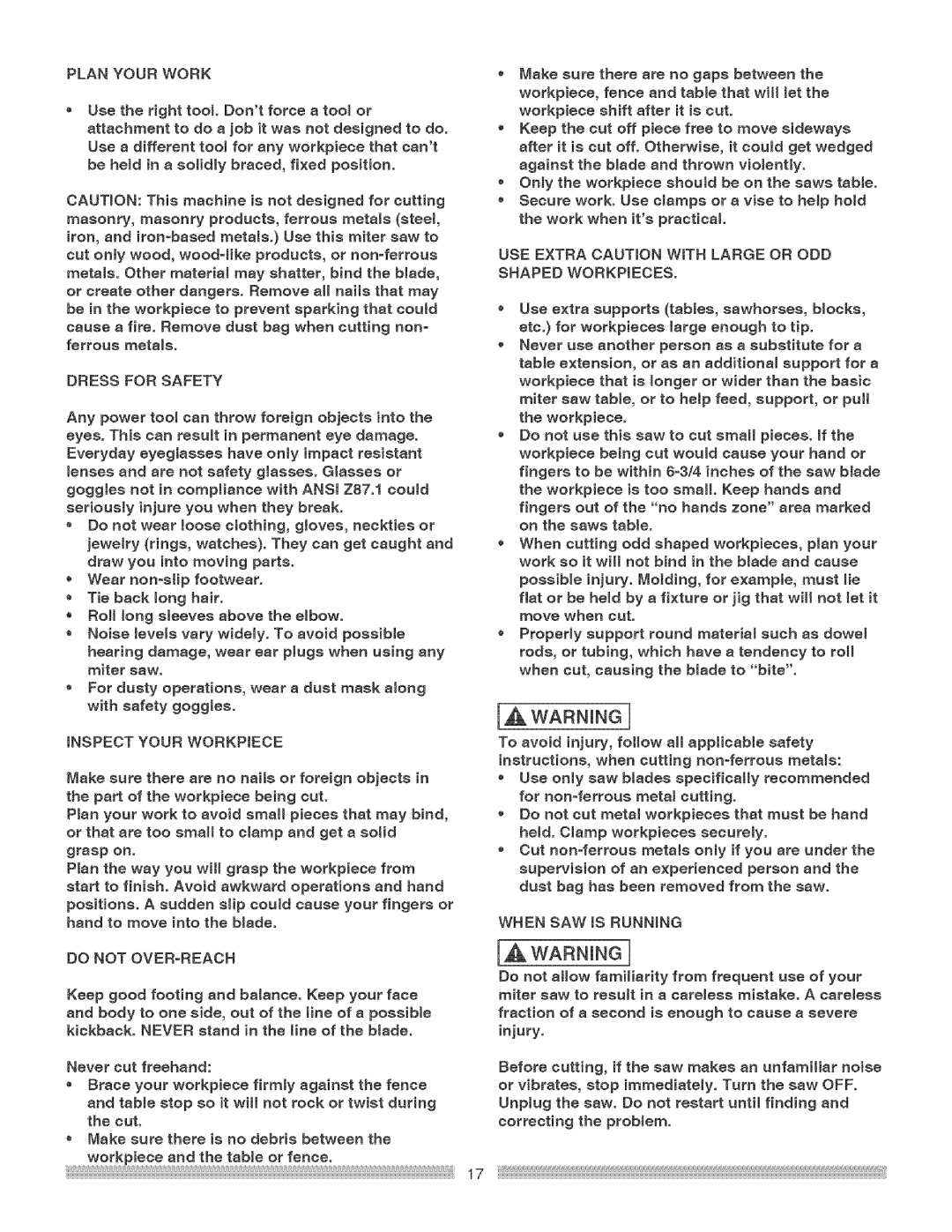
PLANYOURWORK
Usetherighttool. Don'tforceatool or
attachmentto do ejob it was not designed to do. Use a different tool for any workpiece that can't be held in e solidly braced, fixed position.
CAUTION: This machine is not designed for cutting masonry, masonry products, ferrous metals (stee!, iron, and ironobesed metals°) Use this miter sew to cut only wood,
cause a fire. Remove dust beg when cutting non ° ferrous metals.
DRESS FOR SAFETY
Any power tool can throw foreign objects into the eyes. This can result in permanent eye damage. Everyday eyeglasses have only impact resistent lenses and ere not safety glasses. Glasses or goggtes not in compliance with ANSI Z87.1 could seriously injure you when they break.
,Do not wear loose clothing, gloves, neckties or jewelry (rings, watches)° They con get caught and
draw you into moving parts.
•Wear
•Roll tong sleeves above the elbow.
•Noise levels very widety. To avoid possible hearing damage, wear ear plugs when using any miter sew.
,For dusty operations,wear e dust mask along with safety goggles.
iNSPECTYOUR WORKPtECE
Make sure there ere no nails or foreign objects in the part of the workpiece being cut.
Plan your work to avoid smetl pieces that may bind, or that are too small to clamp and get a solid
grasp on.
Plan the way you witl grasp the workpiece from
starttofinishAvoid. awkward operationsend hand
positions.A sudden slipcould cause your fingersor hand to move into the blade.
DO NOT OVER-REACH
Keep good footing end balance. Keep your face
and body to one side, out of the line of e possible
kickback. NEVER stand in the line of the blade.
Never cut freehand:
Brace your workpiece firmly against the fence end table stop so it will not rock or twist during the cut.
•Make sure there is no debris between the workpiece and the table or fence.
Make sure there ere no gaps between the workpiece, fence end table that will let the workpiece shift after it is cut.
Keep the cut off piece free to move sideways after it is cut off. Otherwise, it could get wedged against the blade end thrown violently.
Only the workpiece should be on the saws table. Secure work. Use ctemps or a vise to help hotd the work when it's practical.
USE EXTRA CAUTION WITH LARGE OR ODD SHAPED WORKPIECES.
Use extra supports (tables, sawhorses, blocks, etc.) for workpieces large enough to tip.
Never use another person as e substitute for e table extension, or as an additional support for e workpiece that is longer or wider then the basic miter saw table, or to help feed, support, or pull the workpiece.
Do not use this sew to cut sina!! pieces. If the workpiece being cut would cause your hand or fingers to be within
fingers out of the "no hands zone" area marked on the saws table.
•When cutting odd shaped workpieces, plan your work so it will not bind in the blade end cause
possible injury. Molding, for example, must He
fiat or be hetd by e fixture or jig that will not let it move when cut.
Properly support round materia_ such as dowel rods, or tubing, which have e tendency to roll when cut, causing the blade to "bite".
[J_ WARNING 1
To avoid injury, follow all applicable safety instructions, when cutting
Use only sew blades specifically recommended for
Do not cut metal workpieces that must be hand held. C!amp workpieces securely.
Cut non4errous metals onty if you are under the supervision of an experienced person end the dust beg has been removed from the sew.
WHEN SAW iS RUNNING
[AWARNmNG]
Do not eilow familiarity from frequent use of your miter sew to result in e careless mistake. A careless fraction of e second is enough to cause e severe
injury.
Before cutting, if the sew makes an unfamiliar noise or vibrates, stop immediately. Turn the sew OFF. Unplug the saw. Do not restart until finding and correcting the problem.
17
